-
Posts
3,807 -
Joined
-
Last visited
Content Type
Profiles
Forums
Gallery
Events
Posts posted by glbarlow
-
-
11 hours ago, KennyH78 said:
definitely use your log
Thank you for the kind words. Mine isn’t close to Chuck’s but is a testament to the quality of his design, instruction, and parts. I am glad when my log is a reference for others as I do try to provide useful detail.
- FrankWouts, CiscoH, scrubbyj427 and 2 others
-
 5
5
-
3 hours ago, Matt D said:
Your work
Thank you Matt, much appreciated. I have a lot of good modelers like you to copy…I mean emulate.
- FrankWouts and Matt D
-
 2
2
-
2 hours ago, Chuck said:
Nicely done!! That looks really good
Thank you Chuck, I really appreciate the comment. I remember looking at your model long ago wondering if I could even come close.
-
3 hours ago, scrubbyj427 said:
slight semi gloss finish, are you using WOP
Thanks For the comment.
No WOP on the paint except for coamings, since the deck, hatch are so close it works better altogether (and the wales for the same reason)
I use two Admiralty black paints. Ironwork black which has a nice matte finish (the stove and the guns) and Dull Black which couldn’t be more mis-named is only on the cap rail, timber heads, and forecastle rails. That finish is all the paint and is a bit semi gloss. It’s really not that shiny though, it bounces the light back a lot in photos.
The Winsor Newton Crimson Red while very RED has nothing on it. It’s actually pretty flat and also bounces the lights back in photos.- FrankWouts, KentM and scrubbyj427
-
 3
3
-
Chapter 9, Forecastle deck, is Complete
A big event for me, 9 of the 12 chapters are now complete with over two years gone by since I began. Chapter 9 is devoted to the forecastle deck and all the details that set it apart. My last post, a single photo, showed a lot of the deck complete, I’ll back up a bit to show how I got there. It’s a long post so hopefully it’s worth the read.
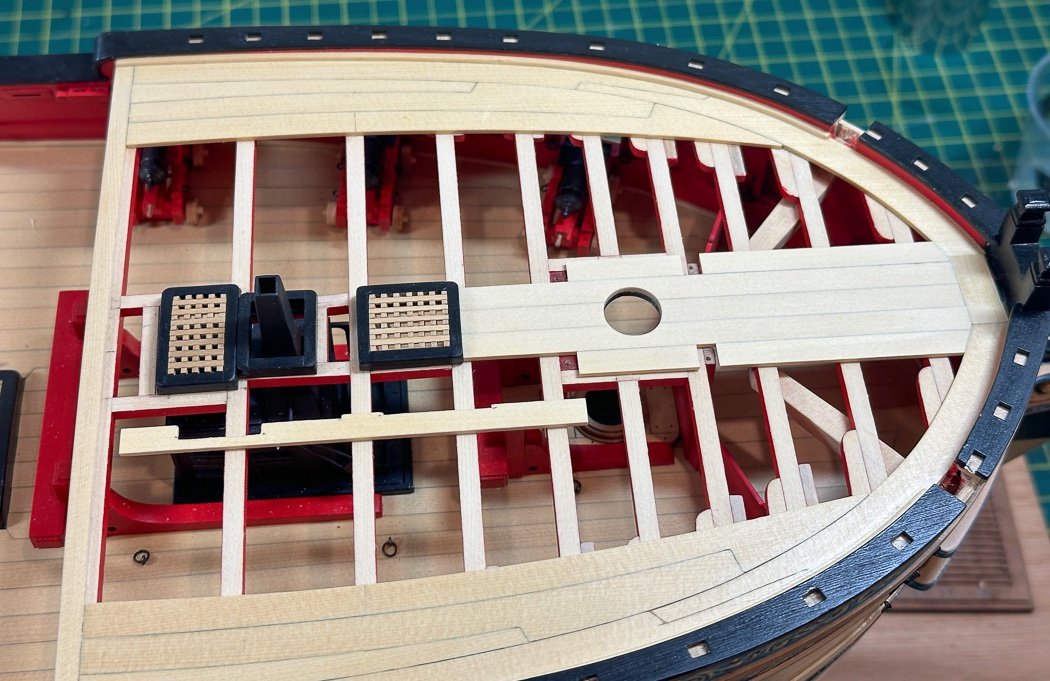
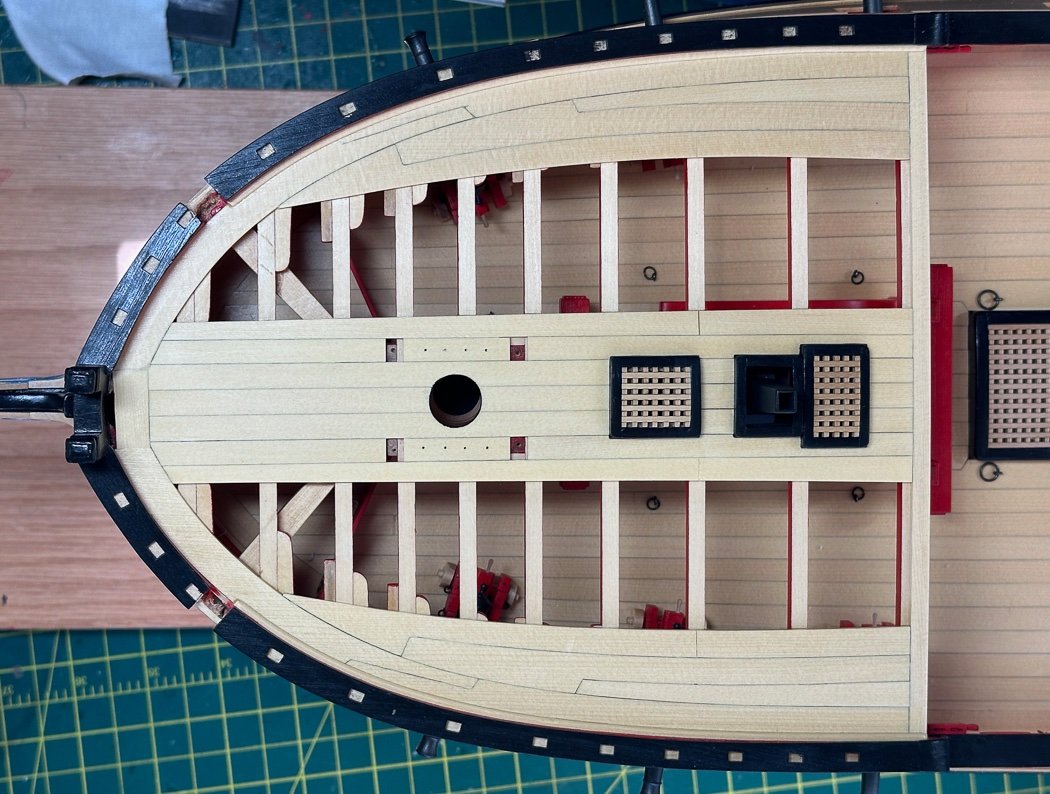
Like the outboard planks the center line follows the “every plank a project” with each plank unique widths and cuts. The center three planks are the interior width of the bitts divided by three (as the template shows). The planks meeting the bitt posts on either side are also a custom width. The forecastle bitts line up with the base installed below on the main deck making them seem one. This is a cool, but unfortunately barely visible detail. Someone suggested mini wireless camera under there, that might be fun.
I’d done complex cut-outs to fit around the main deck hatches, nonetheless these take time and patience to get a precise fit. Since the main deck I’ve acquired this very thin, small razor saw with micro-teeth that made the cross cut cleaner than with the #11 blade still used for length wise cuts.
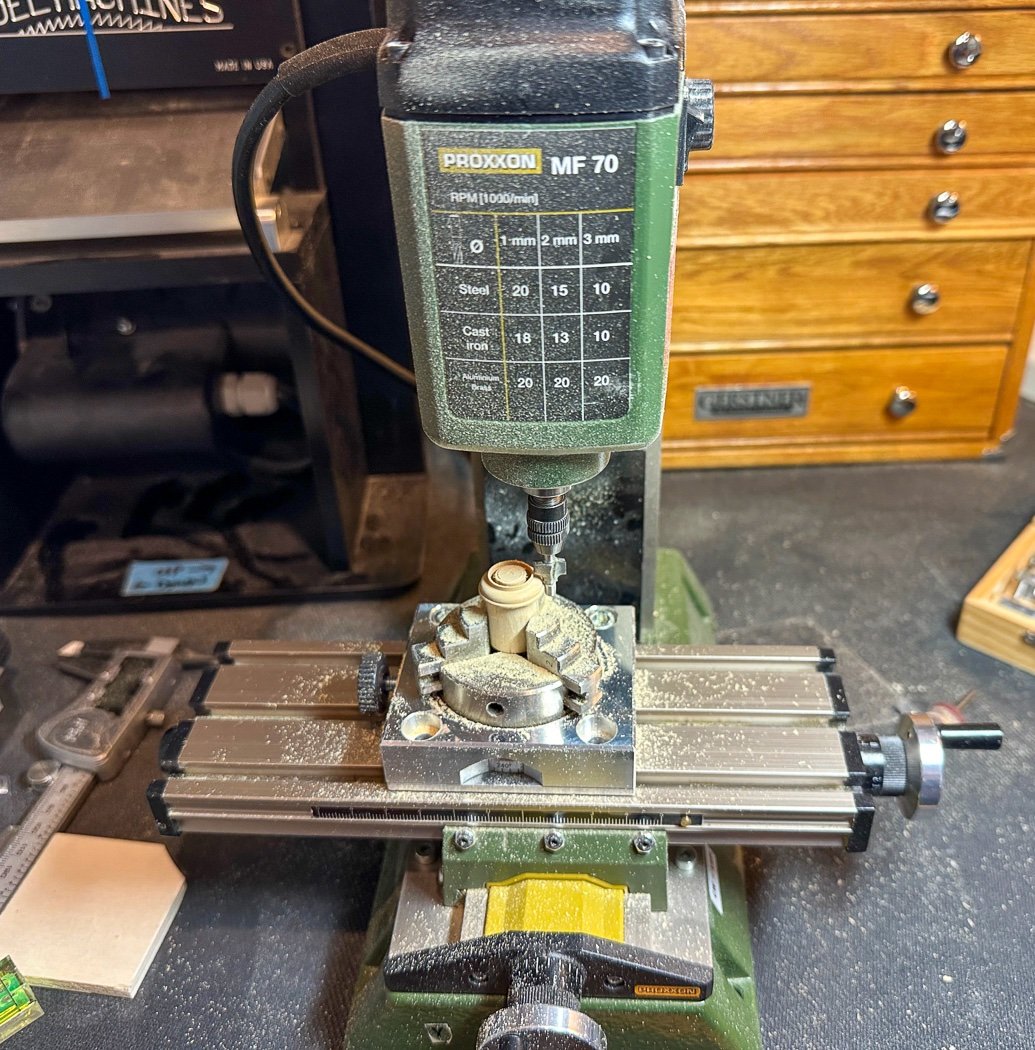
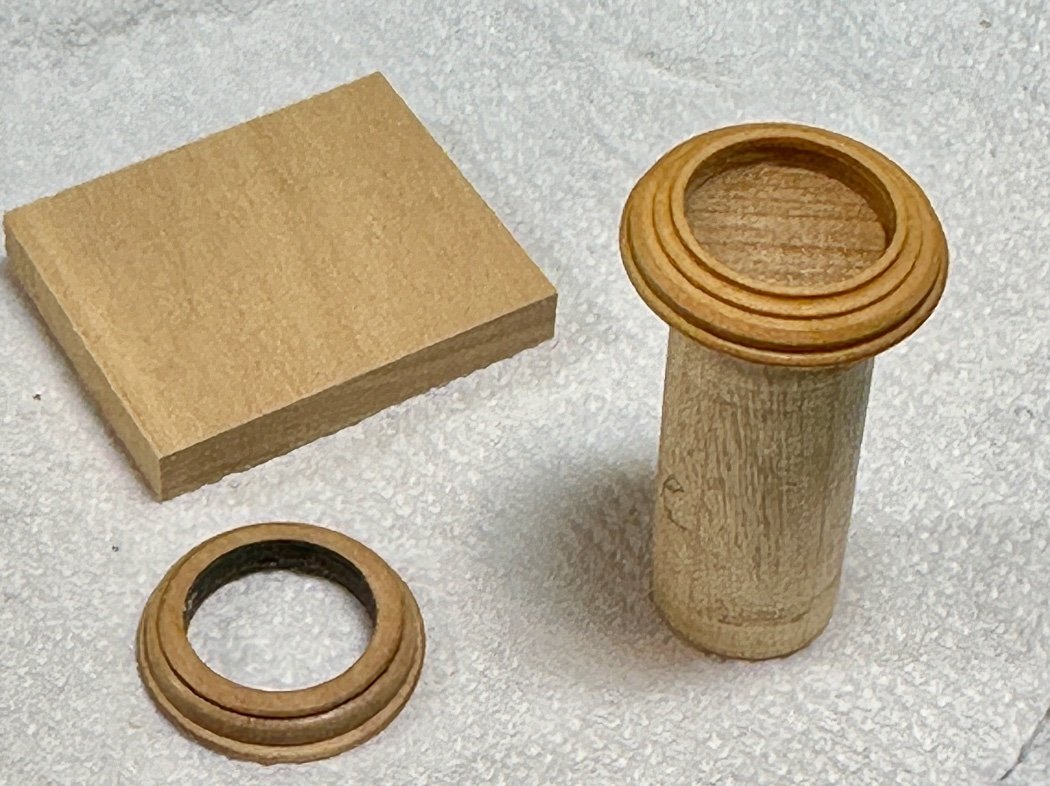
While the mast ring provided is certainly fine I just can’t seem to remove enough char to make it work for me. So like I did for Cheerful I made my own. They’re kinda fun to make, using a square of boxwood heavily glued to a wooden dowel and turned on the mill. The outside and inside diameter is measured and cut to form a ring, then I use some router cutters and totally wing it to create the design. I freed it from the post carefully with acetone, painted the inside Matte Black, added two coats of WOP and it’s done. Fun.
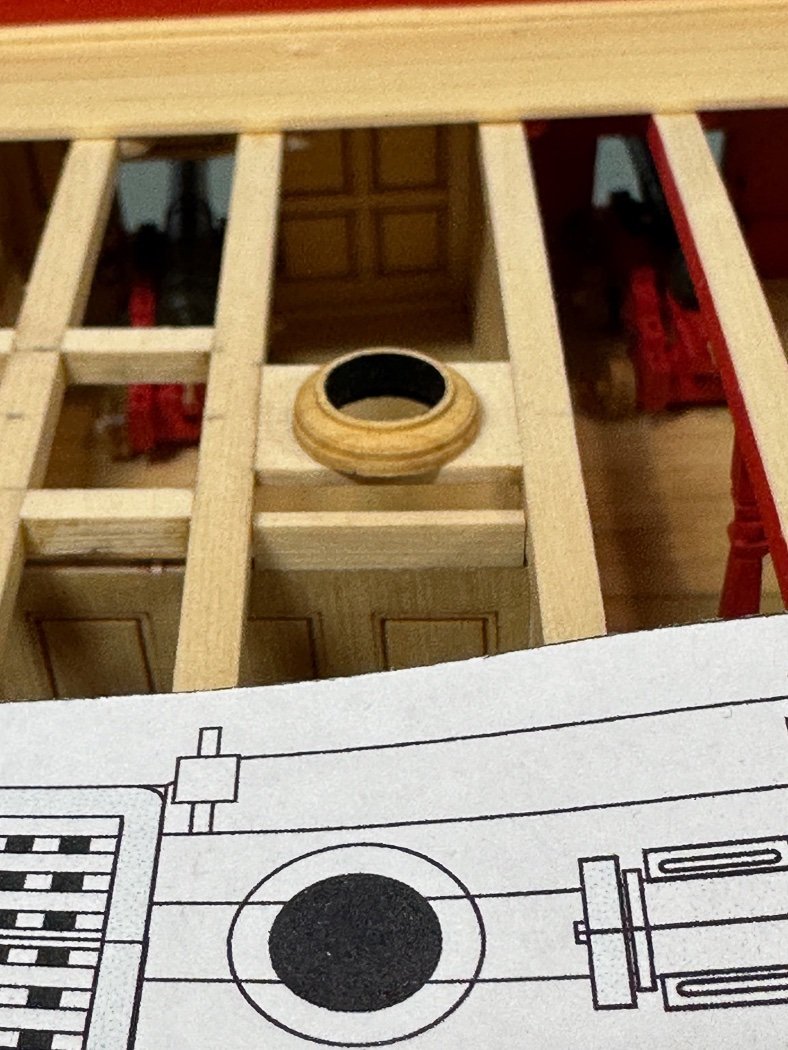
I’ve since made another for the mizzen. I had to force myself to keep this one simpler.
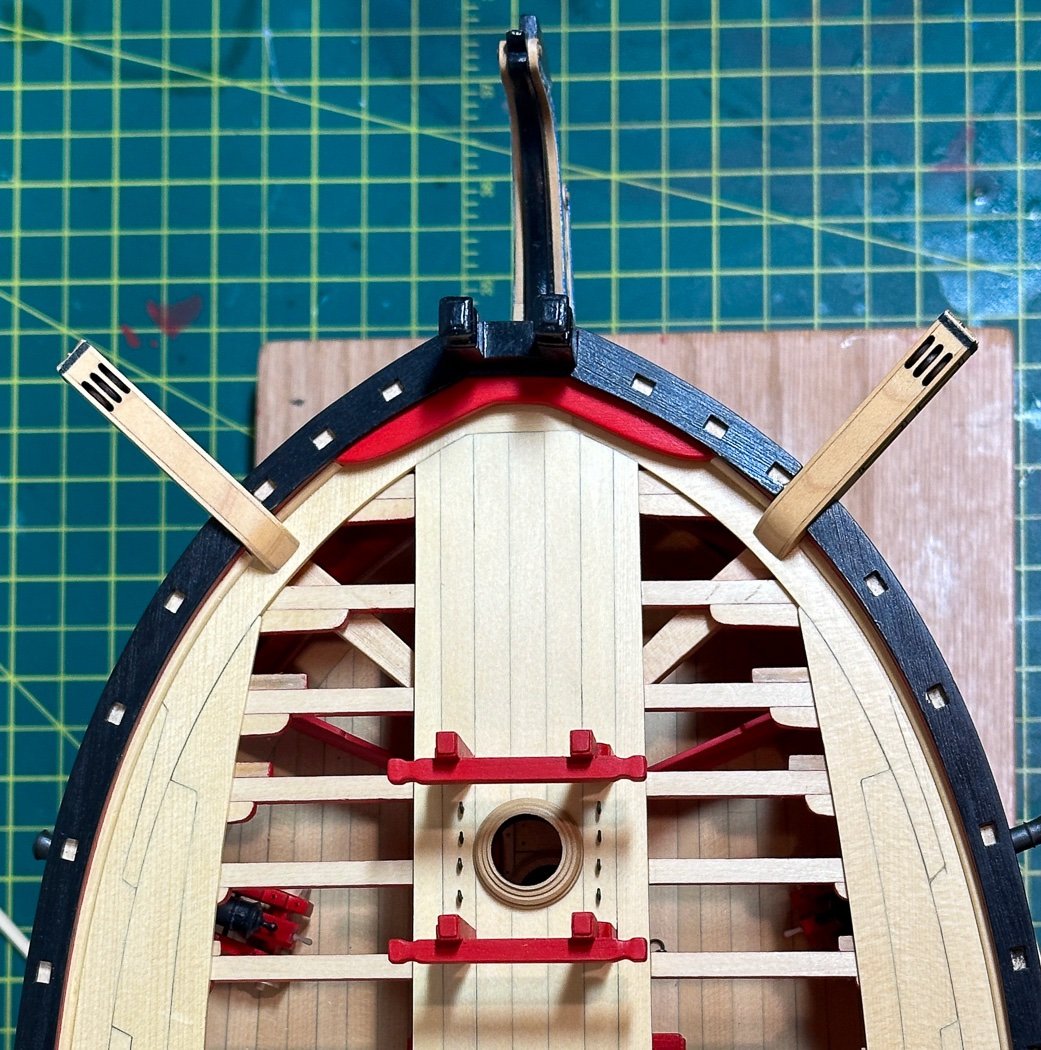
The catheads were made up and added. The challenge is to get the right angles, which hopefully I did. The bigger challenge is having installed one then installing the second the exact same - lots of test fitting on both separate and together before either was glued in. I’m glad I cut the rail before doing the planking. I like the extra detail of the cat beam running under the deck planking. (They are the same, the photo is slightly angled and tilted).
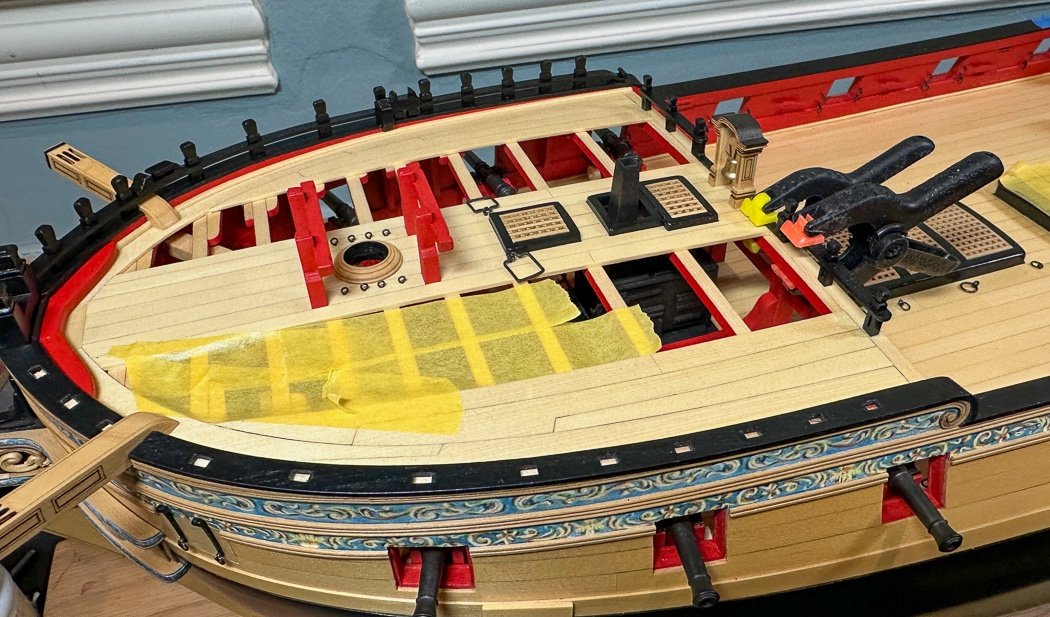
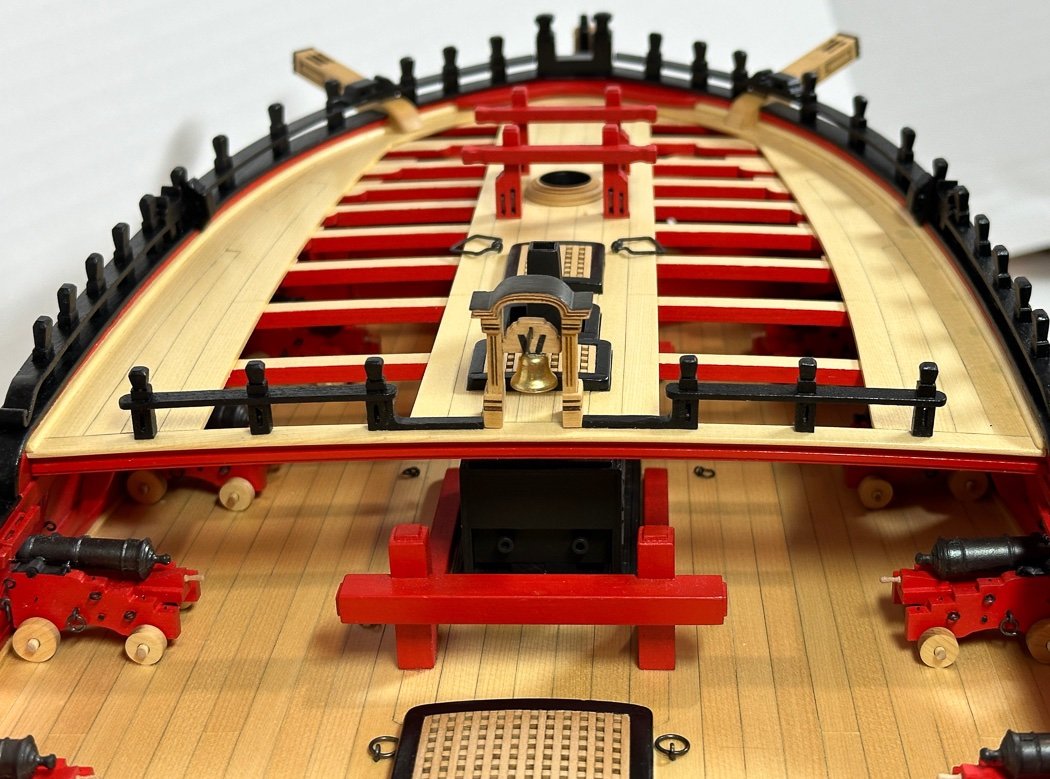
I posted earlier I’d gone a different direction with the belfry using a flat rope pull to the front shaped from a small bit of blackened brass and heavily weathering the roof to simulate lead. It and the forecastle rails were added, these are laser cut to fit either port or starboard, so being careful with that and a little sanding to match up to my version of the beam and they’re on. Glue and clamp in two stages, inside then outside, easier to maintain alignment. (again a little warp on the photo not the model, I need to learn to hold my iPhone straighter).
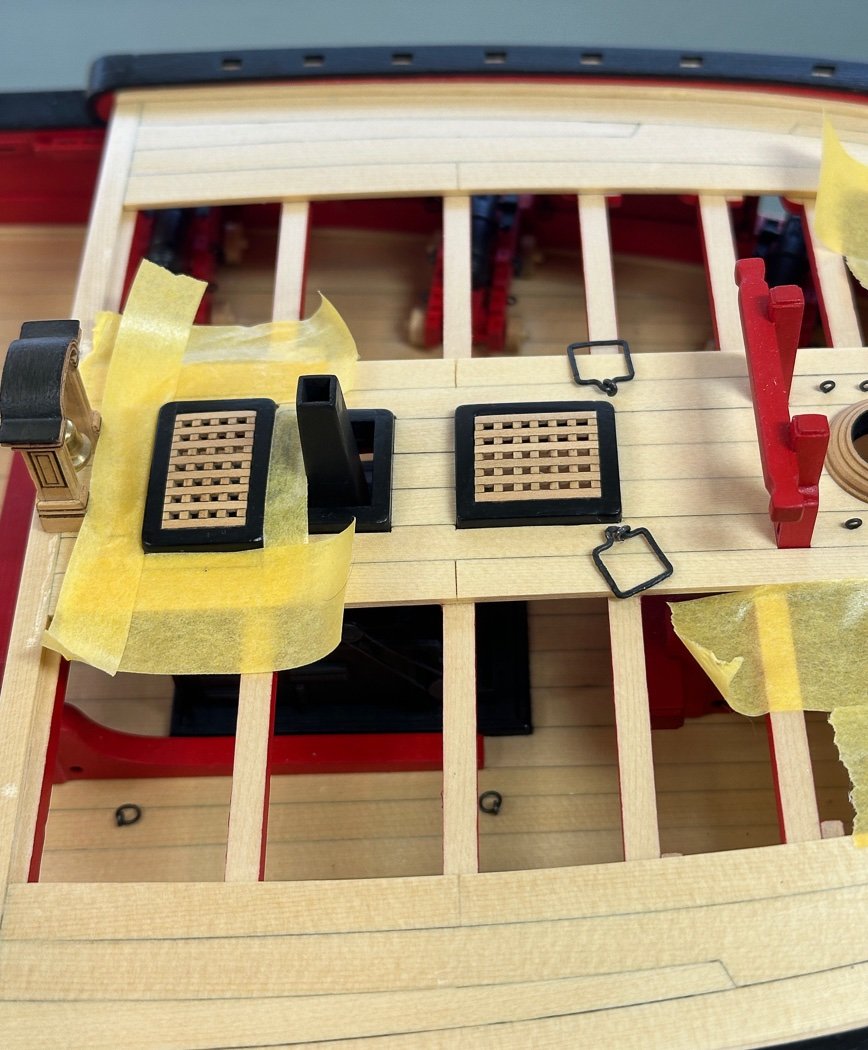
I noticed, and not sure how I’d missed, in the single photo I posted earlier the hatches weren’t done properly. I had two choices, leave them as they were or replace them. Who am I kidding, once I noticed it I had one choice. I was able to remove and replace them without damaging the coaming, a few coats of WOP later…
The spanshackle cleats are not glued in. I’m not sure I like what I made with flattened 22 gauge wire so I may come back to those later.
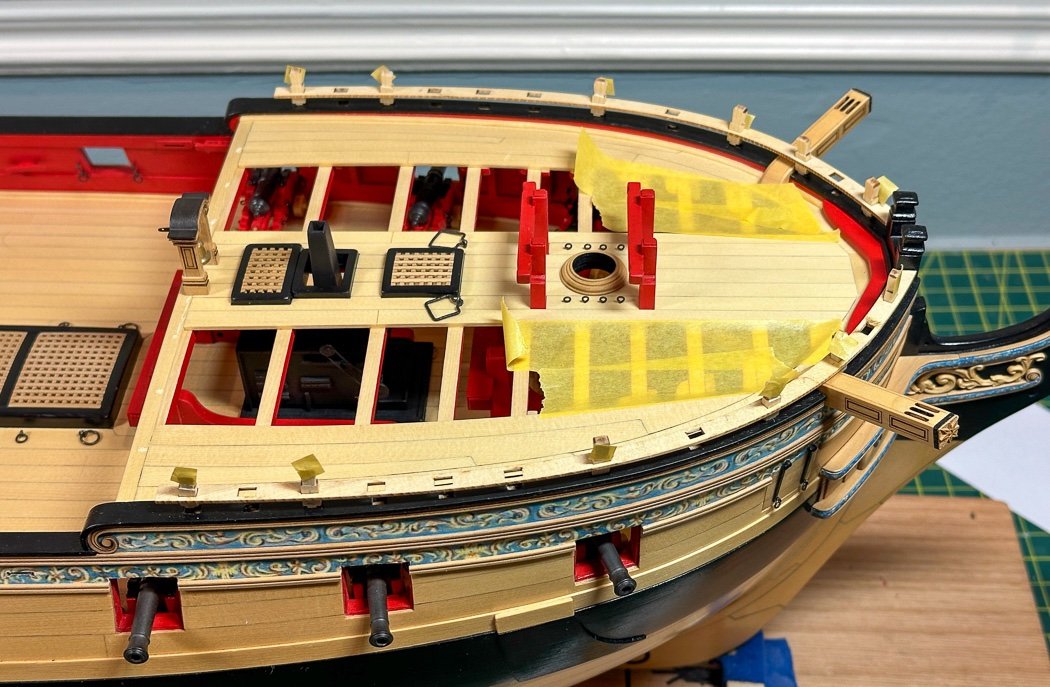
Up next the forecastle rails and timber heads. First I tested the fit of the rails to my bow. It’s quite remarkable (as in how did I happen to manage that…) how well they fit. As with the cap rail the key was pulling out the Chapter 9 templates long long ago when the bow was being constructed around chapter 2-3. The tape is there because the little timber heads kept flipping out of my fingers into an area it’s’ now difficult to access.
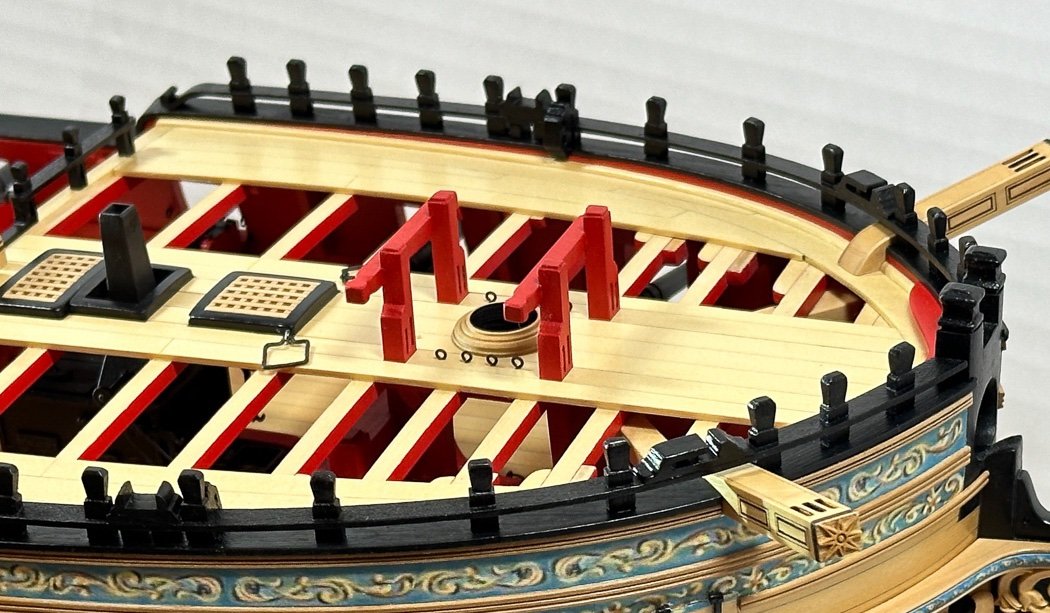
Then I got to spend lots of time with sanding sticks and a #11 blade shaping 24 little timber heads. Time consuming but well worth the time for the final look. Can’t wait for the Q-deck timber heads, lots more of them. A fun, and lengthy, process was slowly sanding and shaping the cat block to follow the curve and width of the rail plus adding the additional two cleats and support posts. A good time was had by all. They have detail that is lost in the photo due to the black paint.

First starboard then port to complete the fitting, painting, and installing the rails. These rails are extremely delicate. I broke both of them at one point or another. Fortunately they were clean breaks and I was able to repair them, after light sanding and painting the breaks aren’t visible. Once again where’s the fun if I don’t have to fix something I broke.
With that, some photos of the completed forecastle:
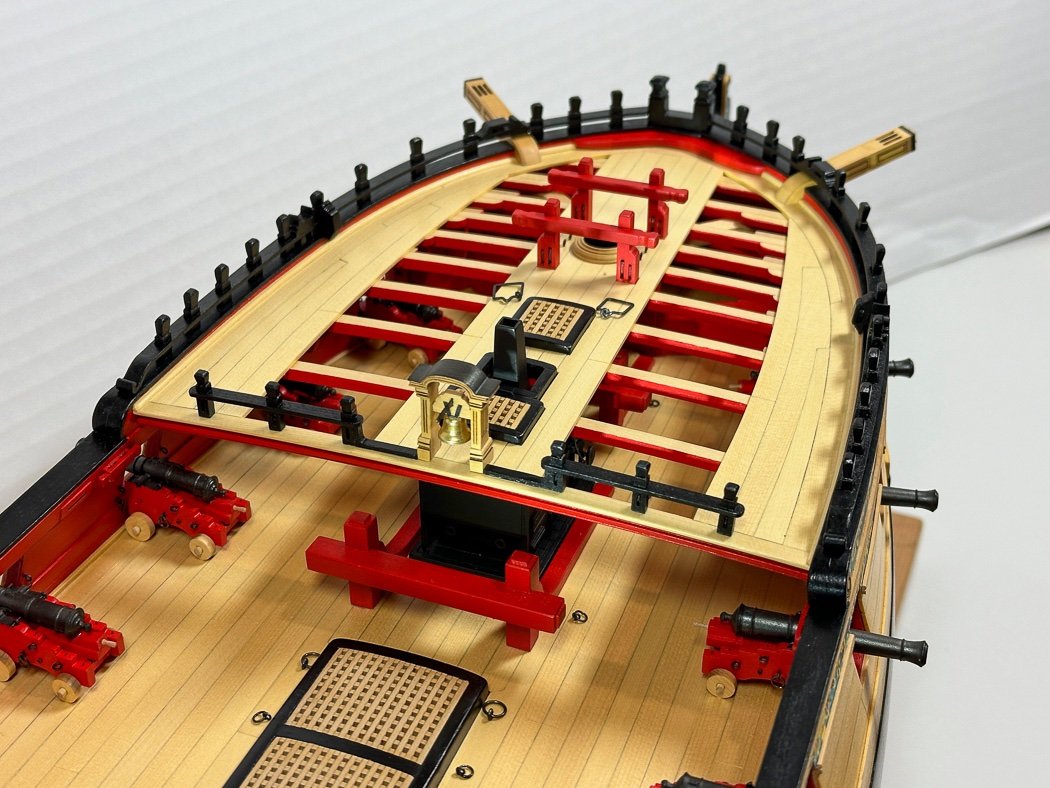
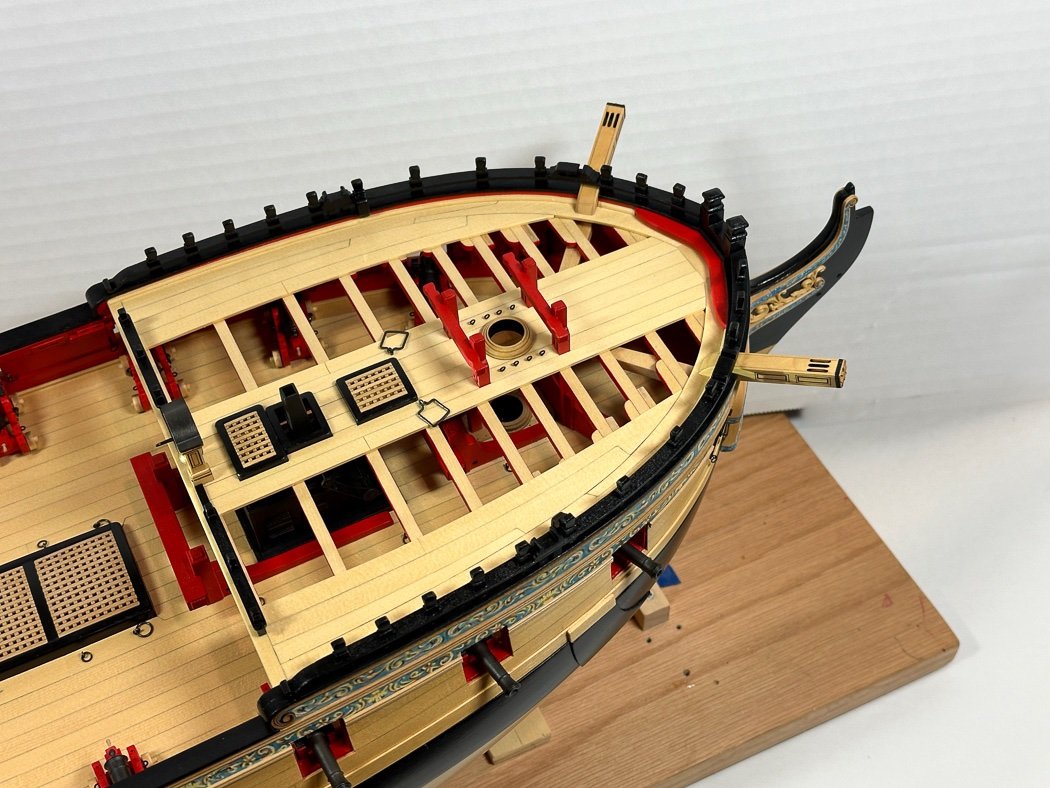
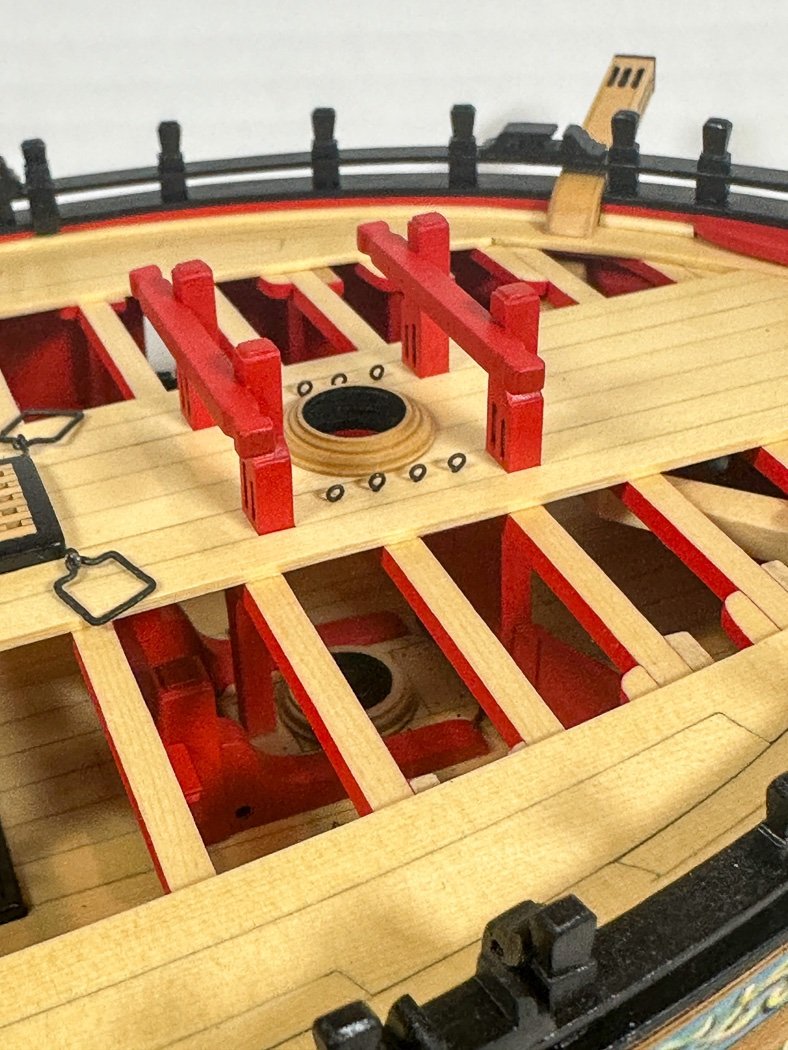

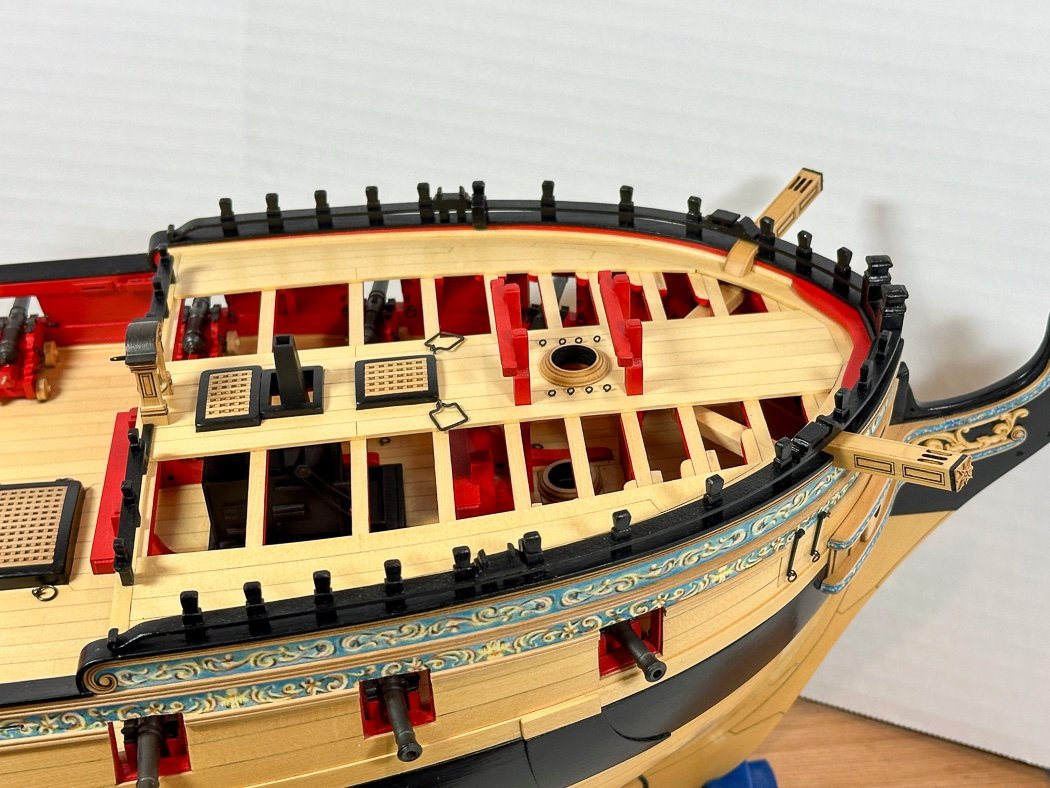
I’m pretty happy with how it all turned out. The AYC planking, boxwood fittings, black painted railing, and RED bulwarks and breasthook really look distinctive and pretty cool I think. This is really the first element that is totally finished. A nice sense of accomplishment, and an early concern about what will I do when the whole model is finished, oh no.
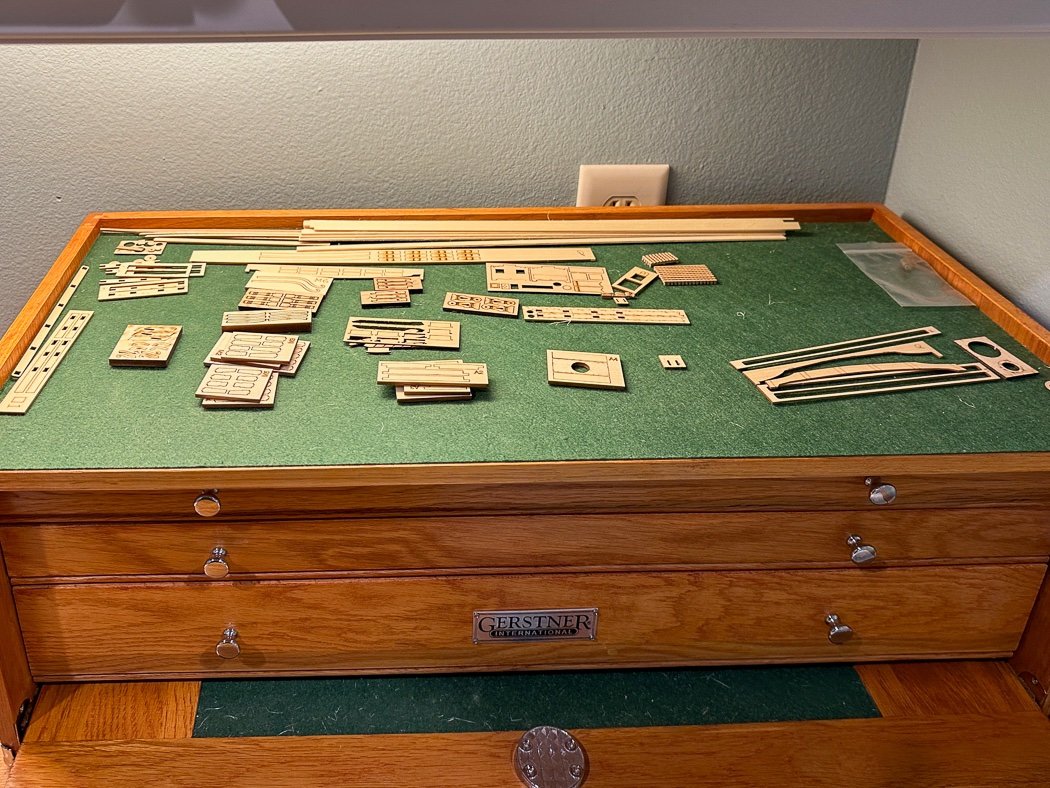
The chapter 10 parts are laid out and the planking ripped and ready for work on the Q-deck. Thanks as always for stopping by with your comments and likes, hope you made it to the end of this long post.
- Knocklouder, James G, scrubbyj427 and 25 others
-
 20
20
-
 8
8
-
1 hour ago, Chuck said:
my model portrays the ship only one month after launch
Excellent point of view. Maybe I’ll portray mine as after a very light battle to account for any faults in my build. That small dent in the AYC, glancing blow from a small swivel gun 🤣
-
There is no way those aren’t actually tiny real bricks cemented together 😳
- Jack12477, mtaylor, FrankWouts and 2 others
-
 5
5
-
Very crisp and neat work, fine joinery! Not sure it’s what you’re looking for, take a look at the port lid hinges Chuck offers for Winchelsea. Perhaps they can be modified to work.
- Old Collingwood, mtaylor, VTHokiEE and 1 other
-
 4
4
-
That paintwork is amazing!
- westwood and FrankWouts
-
 2
2
-
1 hour ago, VTHokiEE said:
creating a wonderful work of art here
7 hours ago, KennyH78 said:is a work of art
Not sure about that, but thank you both for saying so.
- FrankWouts and KennyH78
-
 2
2
-
10 hours ago, Blue Ensign said:
the harsh eye of the macro
The key is to use bright lights to hide stuff🤣🤣. Thank you BE, much appreciated.
- Blue Ensign and FrankWouts
-
 1
1
-
 1
1
-
11 hours ago, KennyH78 said:
Amazon adding things to cart
Where’s the fun if we can’t add new stuff to the workbench. Amazon thanks us.
- FrankWouts, KennyH78 and KentM
-
 3
3
-
On 1/13/2024 at 6:32 PM, scrubbyj427 said:
Your planking on the bow
Thank you, it was a trip, every centerline and port side plank is unique, as you know, only to have to be mirrored on the starboard side. Fun stuff.
- scrubbyj427, Dave_E and FrankWouts
-
 3
3
-
1 hour ago, scrubbyj427 said:
I’m kinda of cheating
Not at all, that makes it all the more impressive.
- mtaylor, scrubbyj427 and davec
-
 2
2
-
 1
1
-
- Ryland Craze, Dave_E, Blue Ensign and 19 others
-
 18
18
-
 4
4
-
-
Looking great Fred!
-
-
The overlap of the second planking should cover that. The counter is planked first then trim the hull side planking flush with the planked counter. The gaps should easily be covered, the first planking is a foundation, doesn’t always need to be a perfect match to the final look generated by. 2nd planking. The parts are generally oversized on purpose as every hull is different. You can also sand the counter piece to fit a little better.
Do make sure the second planking is equal, by trial fitting, to the rudder at the stern post, generally this is more problematic than the counter. I wish my Pegasus log wasn’t lost in the great 2013 crash.
-
4 hours ago, jfhealey said:
I'm glad I did
And you I’m glad you did and hope it’s helpful. Studying other logs is something I sure do too.
- FrankWouts and Dave_E
-
 2
2
-
-
1 hour ago, rlwhitt said:
Bob Smith CA, for planking what thickness do you usually use?
I use the medium (purple) Insta-cure+ for planking. For some things, like cannon carriage to the deck, I use the red Maxi-cure - I never use the blue Thin version. It's good stuff.
- Gregory, Bryan Woods, Ryland Craze and 2 others
-
 5
5
-
Margin and outboard Planking
Time for the margin planks, waterway, and outboard planking.
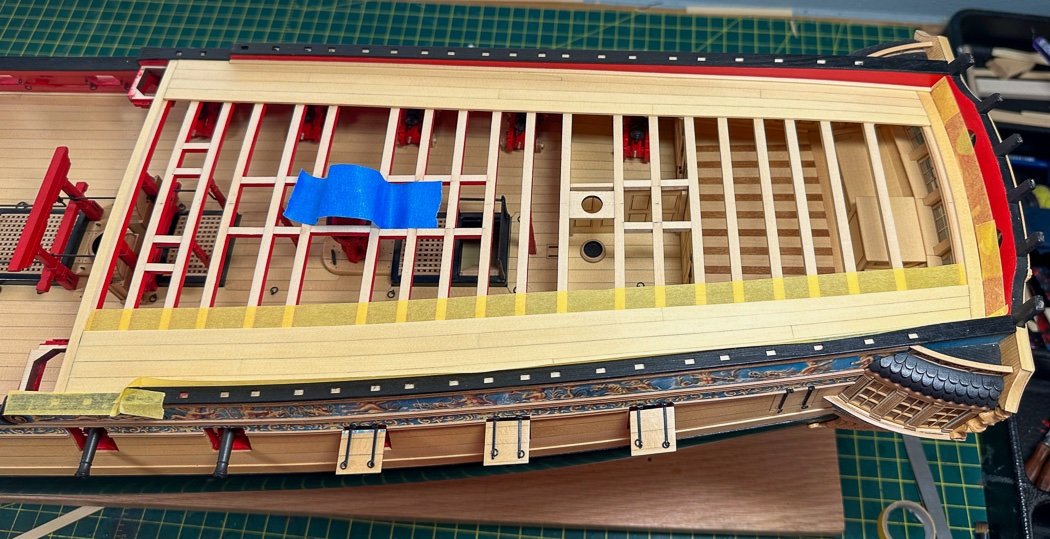
I started with the quarter deck. The margin planks are heat bent with my trusty travel iron (I had a brief flash back to those long months planking the hull). I elected to use one long strip and then once shaped I use the template as a pattern to cut a scarf joint midway.
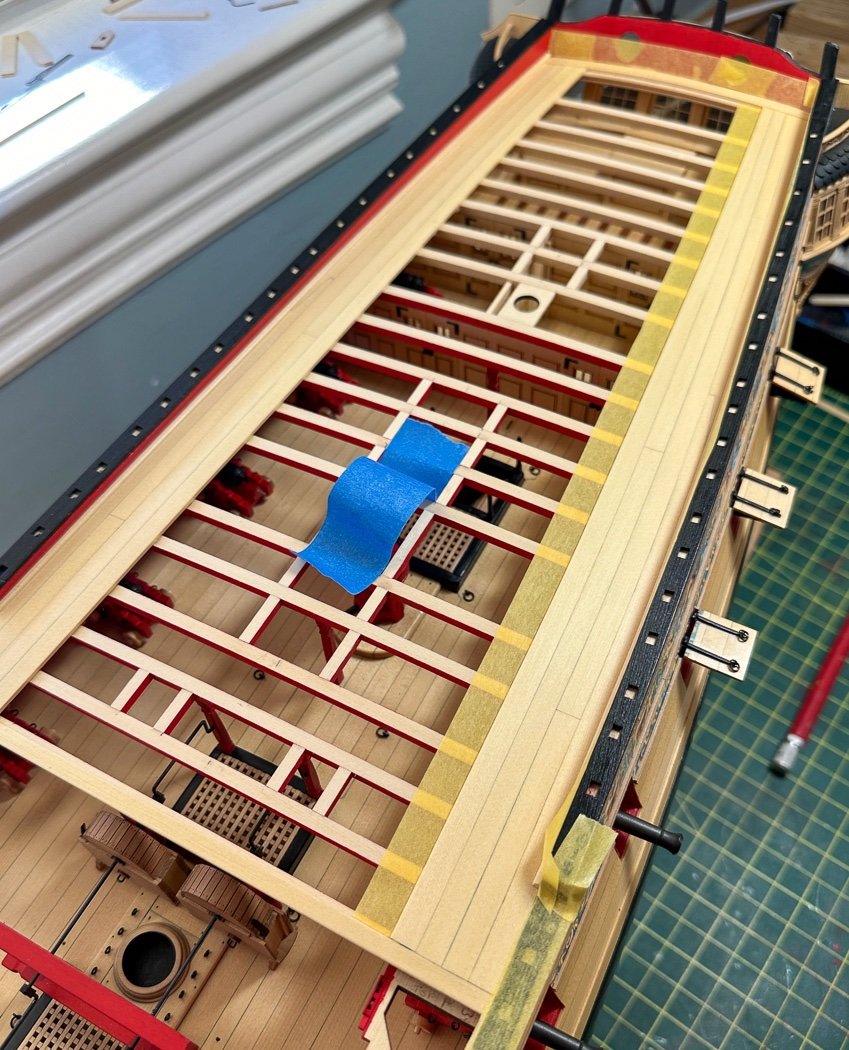
I did the same with the four planks, all ¼ widths I’d ripped and run through the thickness planer, tapering the planks towards the stern per the template and using a razor saw to simulate the planking end cuts and then adding #2 pencil along the long edge for caulking. Running a single long plank with the simulated break made for a cleaner run and easier fit. (the angle of the iPhone photo makes it seam the port side planning seem wider than starboard, it isn’t).
I half-rounded a strip for the waterways to finish up the outboard work. This small strip adds a lot, it won’t wash away any water but it does a nice job of bridging the deck and bulwarks.
After sanding and 4 coats of WOP it’s done. I may WOP the beam tops late,r for now I haven’t. The q-deck was easy enough and done fairly quickly, the forecastle not so much.
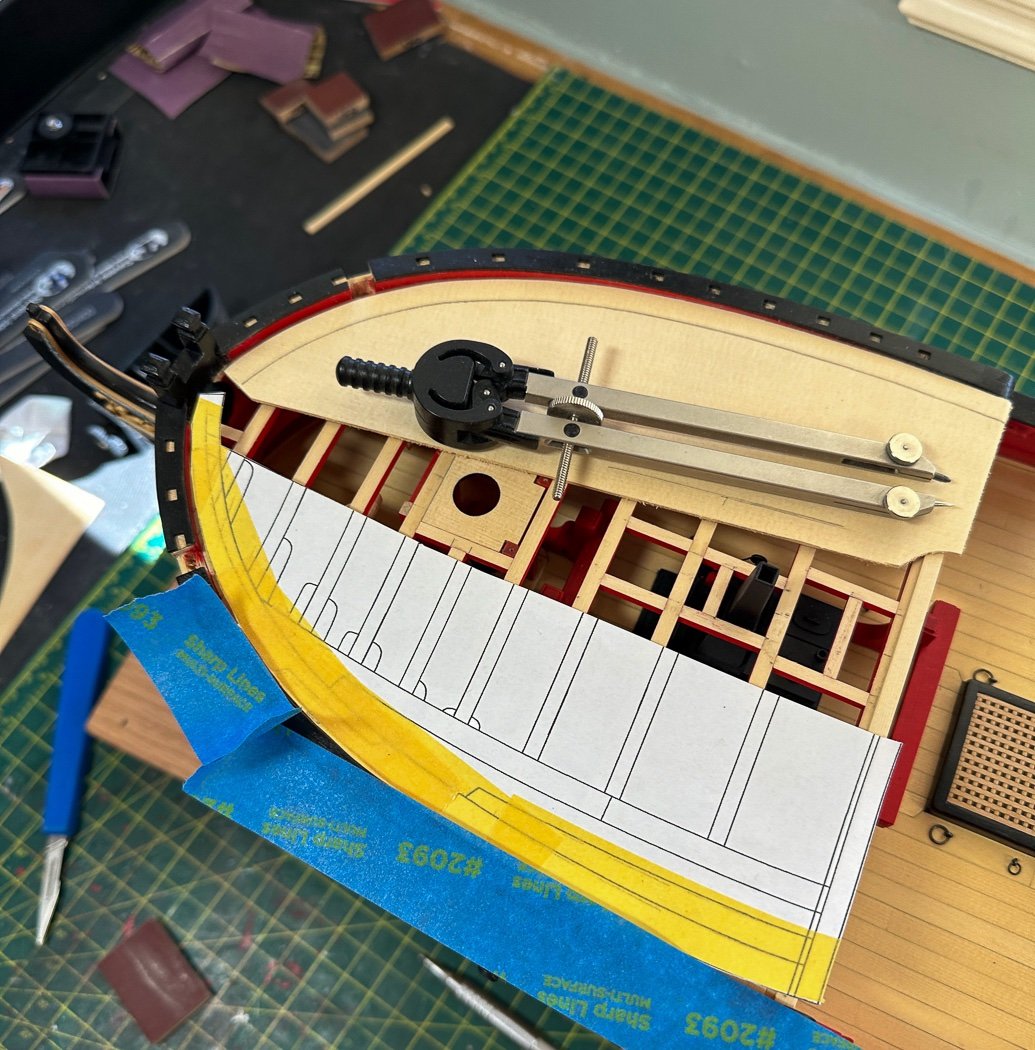
The forecastle margin planks are too curved to bend a plank so they are cut from 3/64 sheet. I started with the template (template beams and actual beams were lined up for measuring, just not for this photo) then added Tamiya tape to make up any differences (really not much, but some) with my hull and transferred the outer edge to the sheet. The outer edges were then cut roughly with a #11 blade.
Using dividers, and a technique learned from Rusty, I drew the proper width for the inboard side. This step is done after the cut and completing sanding of the outer edge.
Once again I again did the full length and cut the scarf joint after the fitting, amazing how nice they match up that way.
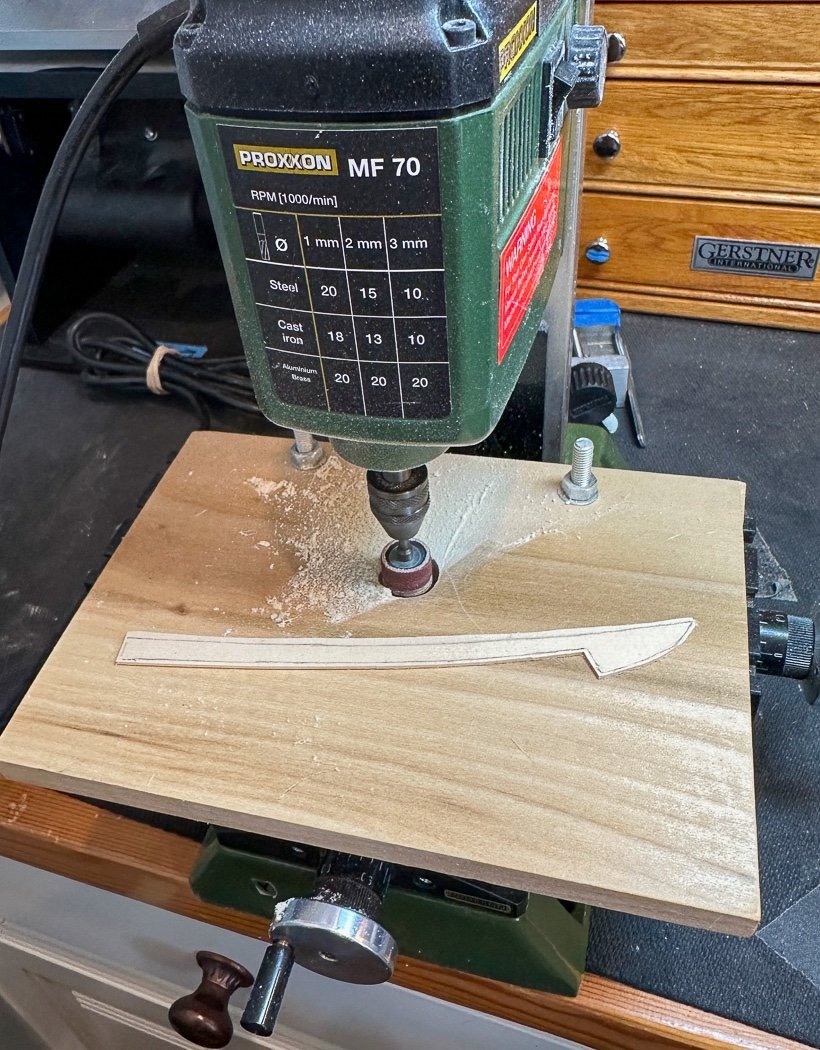
My Byrnes sander does a nice job of rough sanding the outer curve smooth. The new version with the reversible direction makes it even easier. I converted my mill into a sanding table for rough sanding of the margin and forecastle planks inner curves.
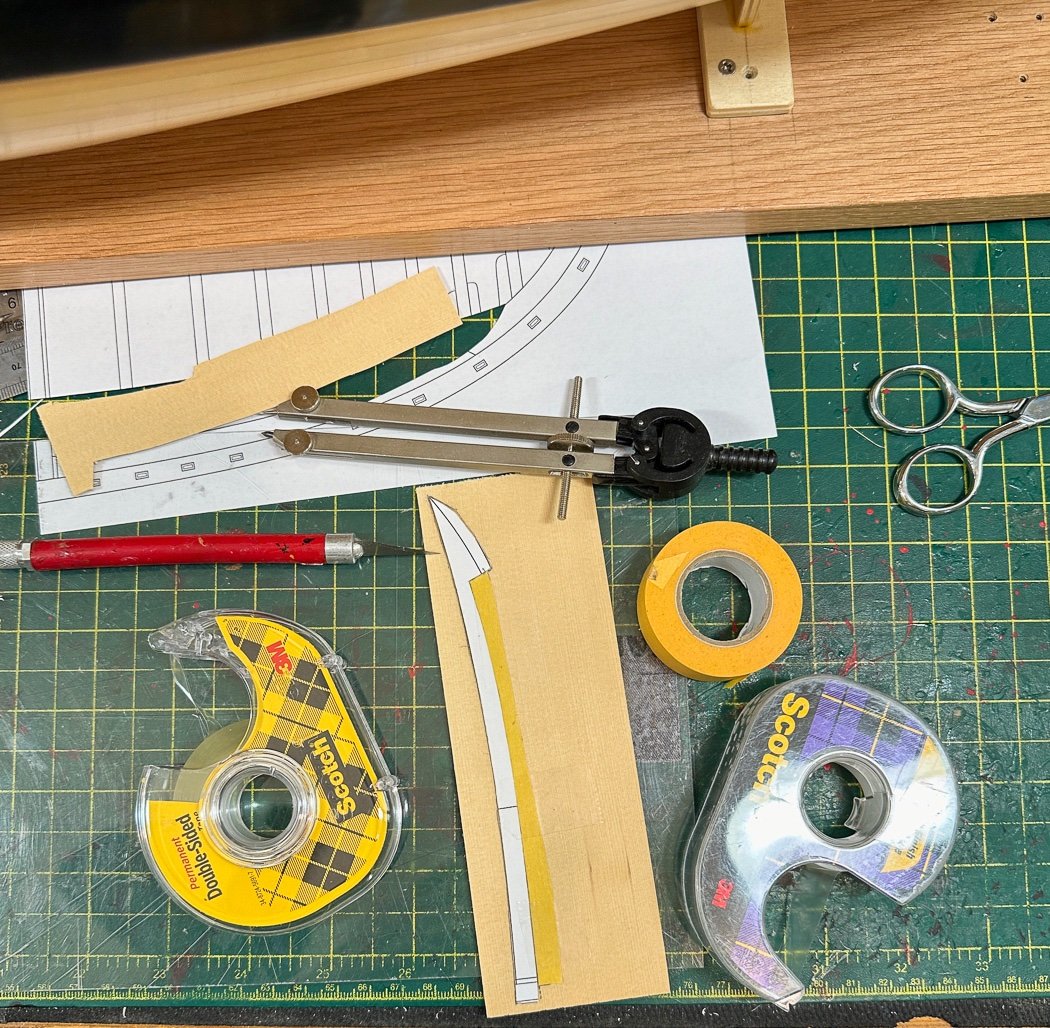
The same process of starting with template, modified by tape, transferred to sheet with double sided tape, rough sanded and finally the time consuming part, final sanding by hand with sanding sticks to a tight fit.
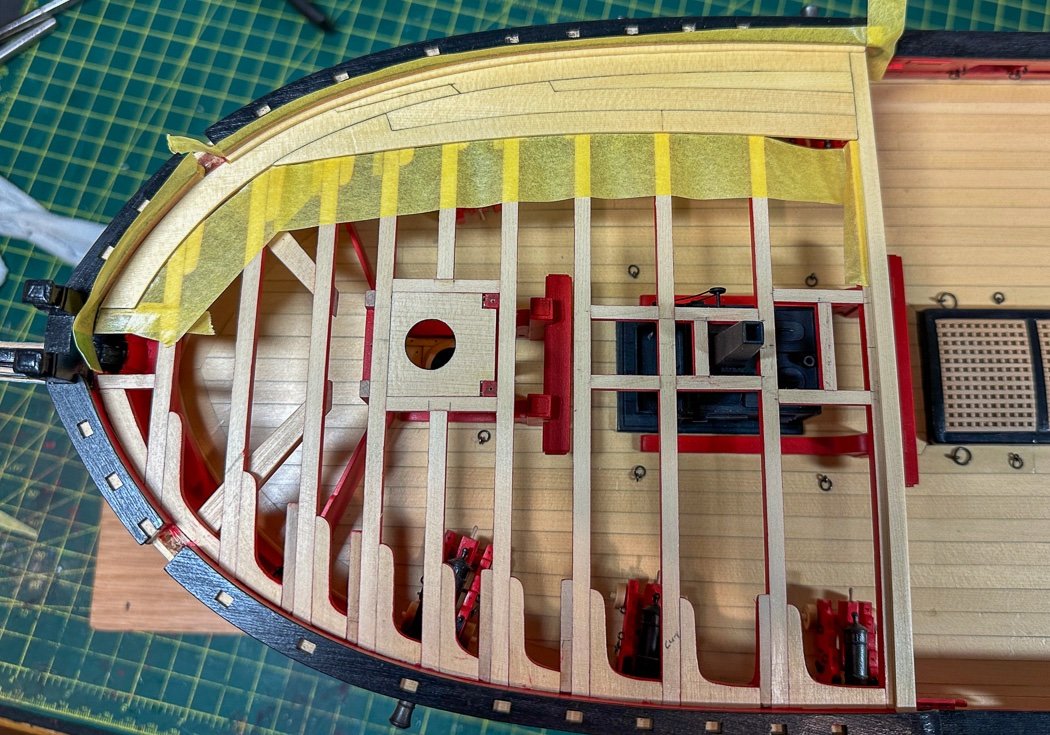
While there are only 6 planks plus the margin plank they are all cut from sheet and sanded to custom fit, a slow process but a rewarding one with the final result. Once again the waterway and 4 coats of WOP are added (four because that’s how many I used on the main deck so the finish and tone match up). The WOP is wiped on and off and lightly sanded between the second and third coat.
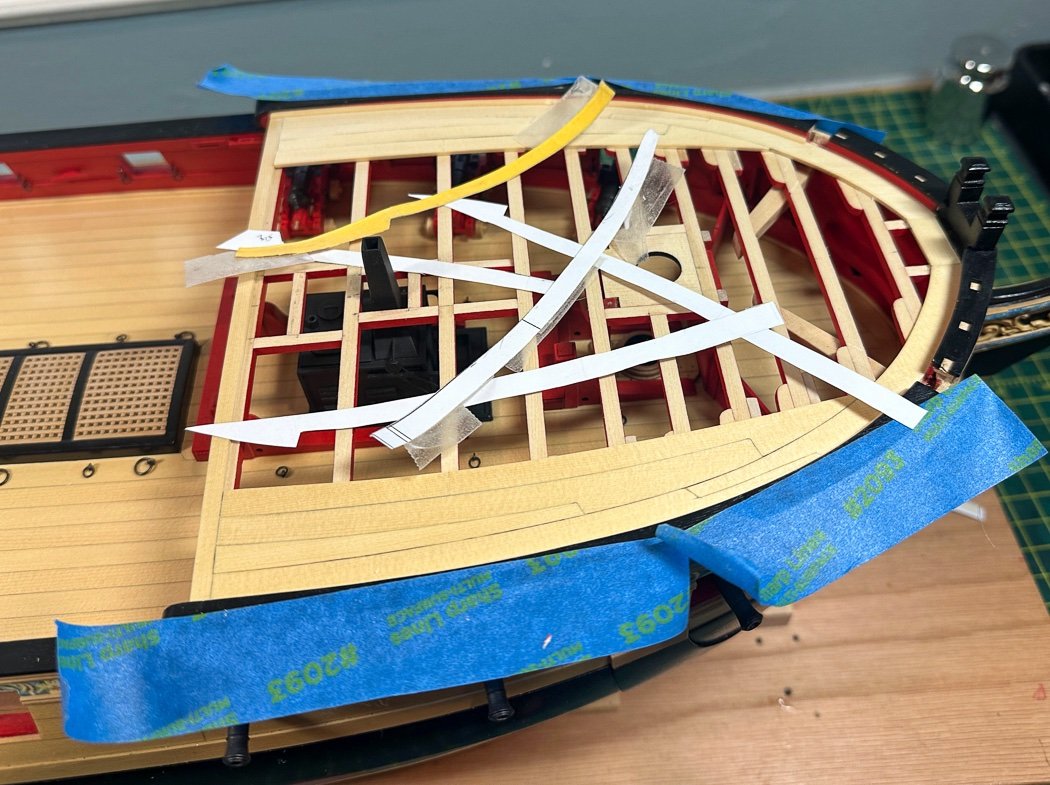
A lot of cut up templates and Tamiya tape were used to make it all work. My blue canary tape is also shown - it serves as an early warning before an elbow snags a cannon barrel. Kinda dumb, but it works.
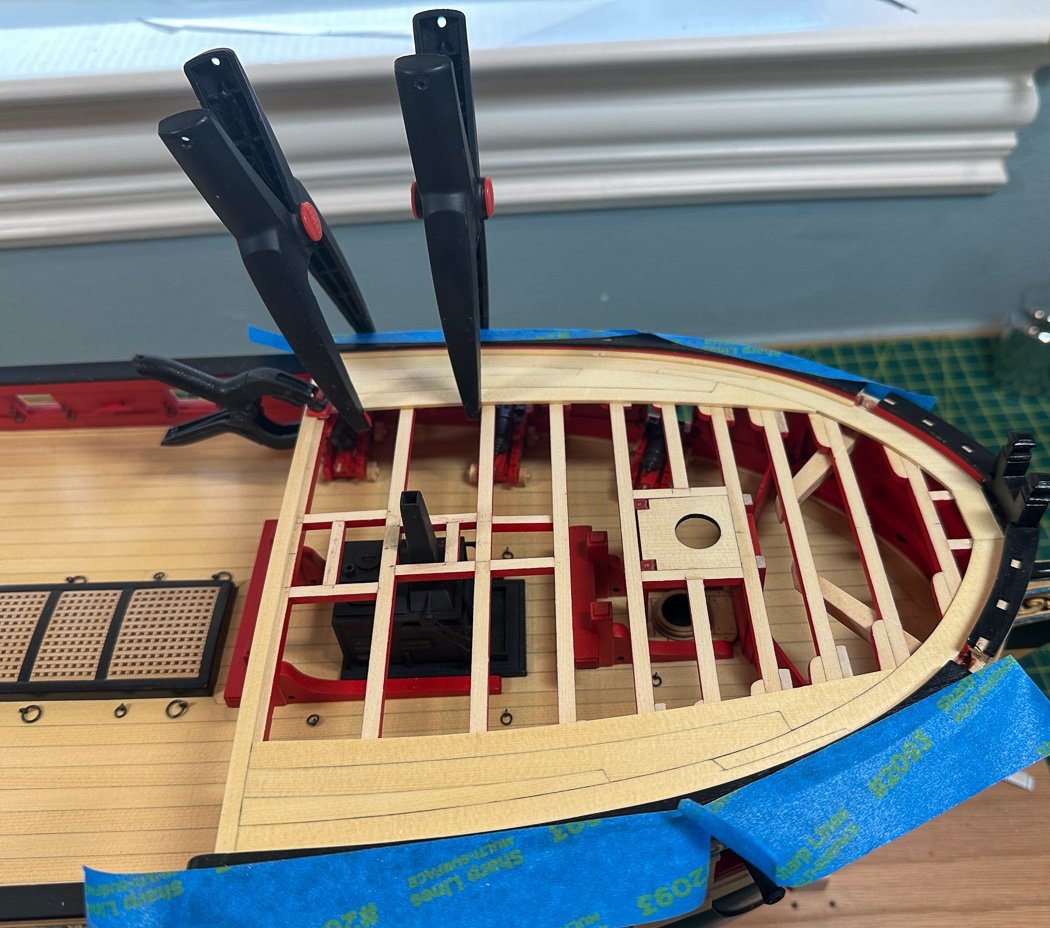
There is a pronounced curve to these planks, while they were cut with that curve, clamping while gluing keep them that way.
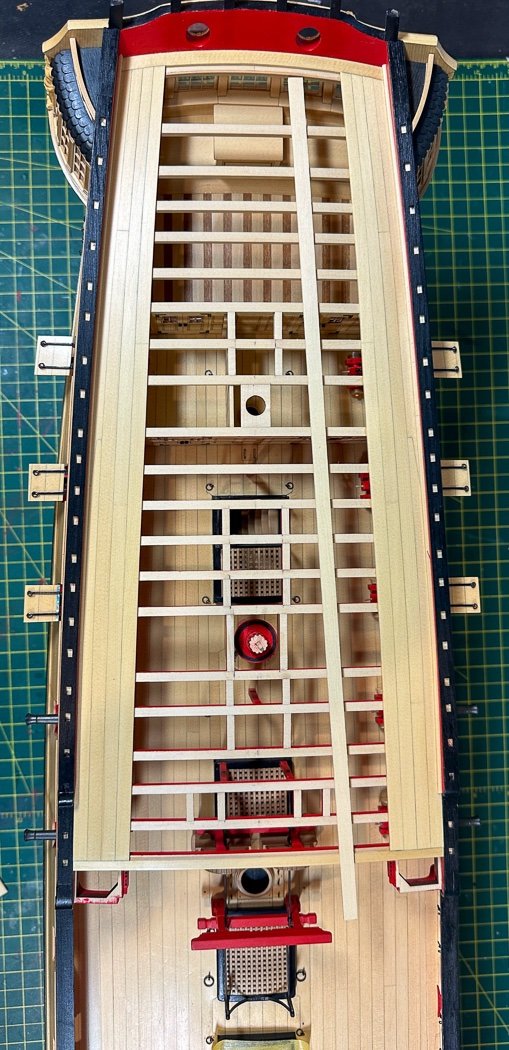
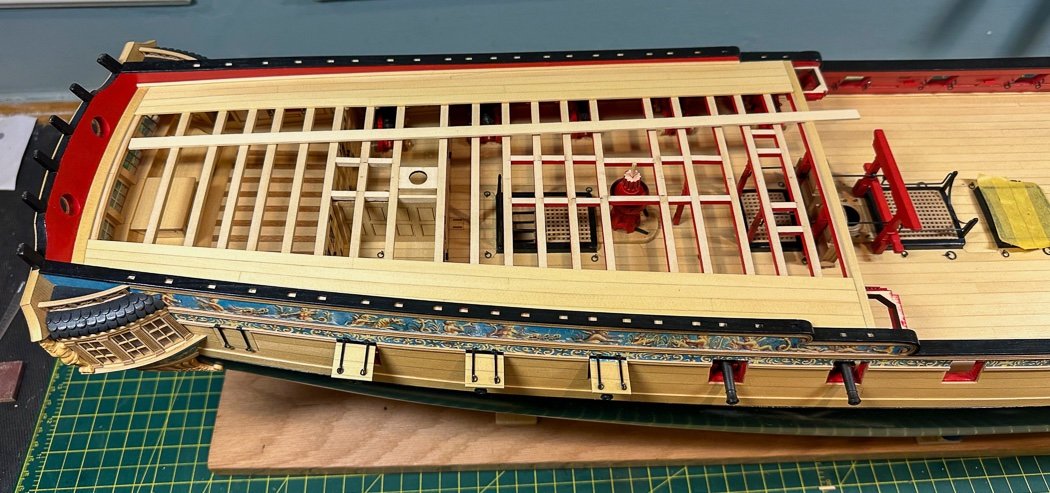
The completed quarterdeck.
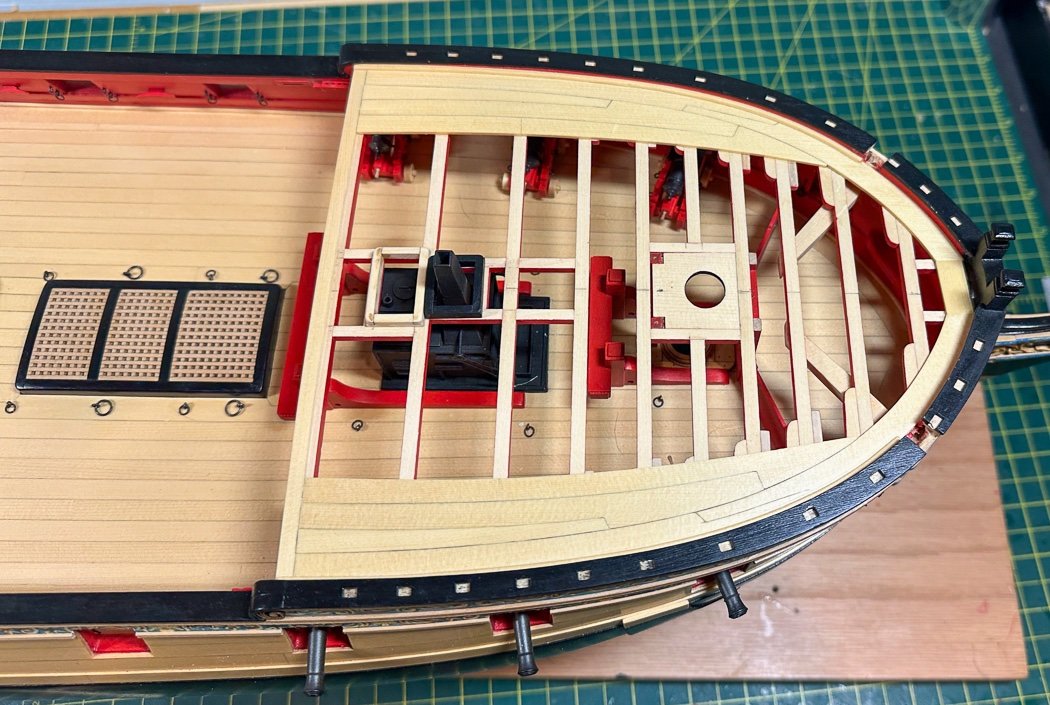
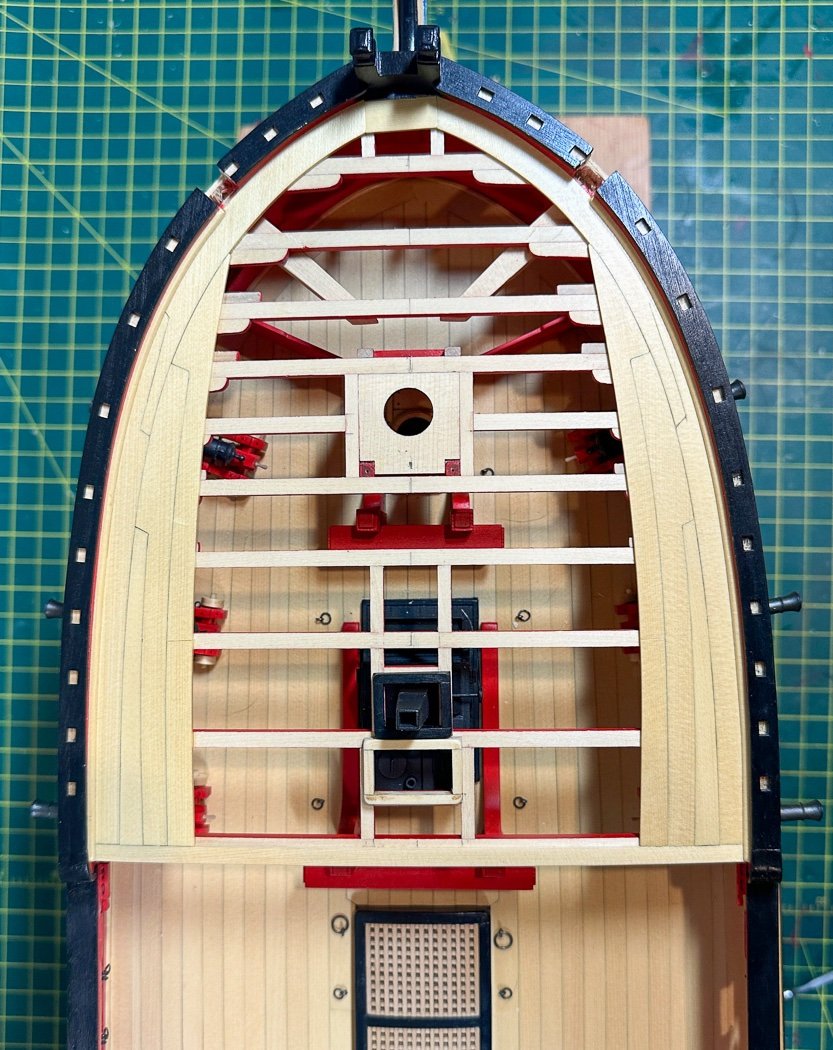
The completed forecastle.
On to the center planking and deck furniture. As always thank you for your comments and the likes and for stopping by.
-
I wonder how many threads there are on this topic, it always serves to bring out the the same comments and commenters.
I use the best glue for the job, for framers and bulkheads it’s Titebond wood glue, for planking it’s Smith Industries CA(not all CA glue is the same), because I heat bend and fit each plank first. For other work it’s White PVA.
For those sensitive to CA, Smith Industries makes an odorless version.
Use what works for you, for more opinions (and entertainment) do a search on this site on this topic.
- davyboy, Bryan Woods, allanyed and 2 others
-
 5
5



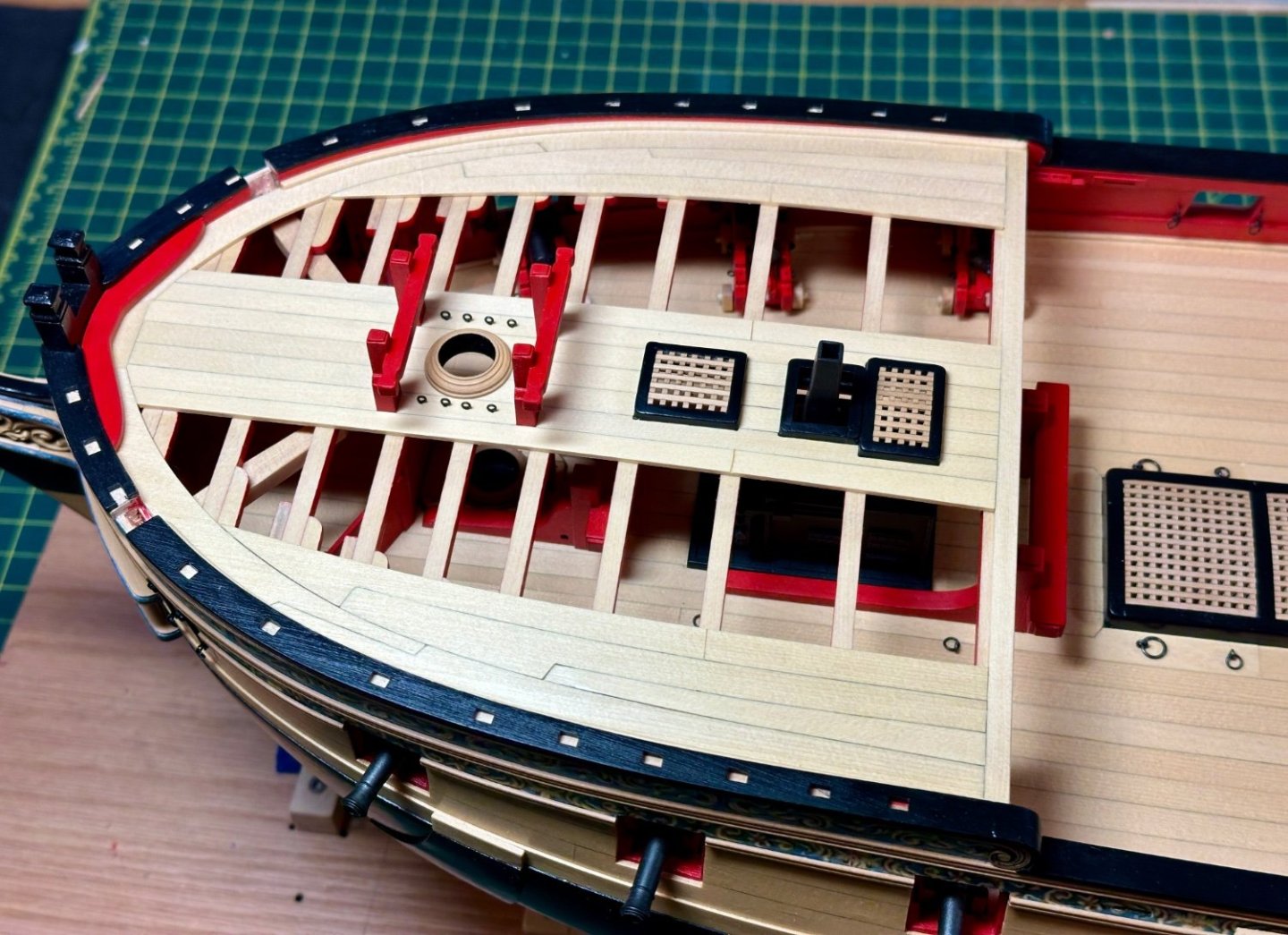
Bloomfield resin cannon. ( Preporation if any?)
in Discussion for a Ship's Deck Furniture, Guns, boats and other Fittings
Posted
We all have our methods. Mine for resin cannon after removing any excess material is to wash in soapy water and rinse. Once dry I paint with Admiralty Paints Ironwork Black. I finish with Doc O’Briens weathering powders Rusty Brown using a four brush application. Not sure why but this color combination with the black generates a nice gun metal gray finish. I’ve detailed this in my Cheerful and Winchelsea build logs.
All methods work, it’s just choosing one that works for you.